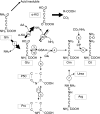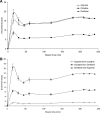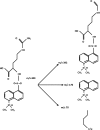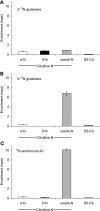Glutamine: precursor or nitrogen donor for citrulline synthesis?
- PMID: 20407005
- PMCID: PMC2904050
- DOI: 10.1152/ajpendo.00080.2010
Glutamine: precursor or nitrogen donor for citrulline synthesis?
Abstract
Although glutamine is considered the main precursor for citrulline synthesis, the current literature does not differentiate between the contribution of glutamine carbon skeleton vs. nonspecific nitrogen (i.e., ammonia) and carbon derived from glutamine oxidation. To elucidate the role of glutamine and nonspecific nitrogen in the synthesis of citrulline, l-[2-(15)N]- and l-[5-(15)N]glutamine and (15)N-ammonium acetate were infused intragastrically in mice. The amino group of glutamine labeled the three nitrogen groups of citrulline almost equally. The amido group and ammonium acetate labeled the ureido and amino groups of citrulline, but not the delta-nitrogen. D(5)-glutamine also infused in this arm of the study, which traces the carbon skeleton of glutamine, was utilized poorly, accounting for only 0.2-0.4% of the circulating citrulline. Dietary glutamine nitrogen (both N groups) incorporation was 25-fold higher than the incorporation of its carbon skeleton into citrulline. To investigate the relative contributions of the carbon skeleton and nonspecific carbon of glutamine, arginine, and proline to citrulline synthesis, U-(13)C(n) tracers of these amino acids were infused intragastrically. Dietary arginine was the main precursor for citrulline synthesis, accounting for approximately 40% of the circulating citrulline. Proline contribution was minor (3.4%), and glutamine was negligible (0.4%). However, the glutamine tracer resulted in a higher enrichment in the ureido group, indicating incorporation of nonspecific carbon from glutamine oxidation into carbamylphosphate used for citrulline synthesis. In conclusion, dietary glutamine is a poor carbon skeleton precursor for the synthesis of citrulline, although it contributes both nonspecific nitrogen and carbon to citrulline synthesis.
Figures





Comment in
-
Glutamine: precursor or nitrogen donor for citrulline synthesis?Am J Physiol Endocrinol Metab. 2010 Oct;299(4):E683; author reply E684. doi: 10.1152/ajpendo.00425.2010. Am J Physiol Endocrinol Metab. 2010. PMID: 20876770 No abstract available.
Similar articles
-
Enteral arginase II provides ornithine for citrulline synthesis.Am J Physiol Endocrinol Metab. 2011 Jan;300(1):E188-94. doi: 10.1152/ajpendo.00413.2010. Epub 2010 Oct 26. Am J Physiol Endocrinol Metab. 2011. PMID: 20978229 Free PMC article.
-
Plasma Glutamine Is a Minor Precursor for the Synthesis of Citrulline: A Multispecies Study.J Nutr. 2017 Apr;147(4):549-555. doi: 10.3945/jn.116.243592. Epub 2017 Mar 8. J Nutr. 2017. PMID: 28275102 Free PMC article.
-
De novo synthesis is the main source of ornithine for citrulline production in neonatal pigs.Am J Physiol Endocrinol Metab. 2012 Dec 1;303(11):E1348-53. doi: 10.1152/ajpendo.00399.2012. Epub 2012 Oct 16. Am J Physiol Endocrinol Metab. 2012. PMID: 23074237 Free PMC article.
-
Interrelationships between glutamine and citrulline metabolism.Curr Opin Clin Nutr Metab Care. 2016 Jan;19(1):62-6. doi: 10.1097/MCO.0000000000000233. Curr Opin Clin Nutr Metab Care. 2016. PMID: 26560519 Free PMC article. Review.
-
Comparative aspects of tissue glutamine and proline metabolism.J Nutr. 2008 Oct;138(10):2032S-2039S. doi: 10.1093/jn/138.10.2032S. J Nutr. 2008. PMID: 18806120 Review.
Cited by
-
Alterations in glutamine metabolism and its conversion to citrulline in sepsis.Am J Physiol Endocrinol Metab. 2013 Jun 15;304(12):E1359-64. doi: 10.1152/ajpendo.00628.2012. Epub 2013 Apr 23. Am J Physiol Endocrinol Metab. 2013. PMID: 23612995 Free PMC article.
-
Activated whole-body arginine pathway in high-active mice.PLoS One. 2020 Jun 26;15(6):e0235095. doi: 10.1371/journal.pone.0235095. eCollection 2020. PLoS One. 2020. PMID: 32589680 Free PMC article.
-
Citrulline Generation Test: What Does It Measure?JPEN J Parenter Enteral Nutr. 2019 Aug;43(6):726-733. doi: 10.1002/jpen.1462. Epub 2018 Oct 24. JPEN J Parenter Enteral Nutr. 2019. PMID: 30357864 Free PMC article.
-
The Citrulline Recycling Pathway Sustains Cardiovascular Function in Arginine-Depleted Healthy Mice, but Cannot Sustain Nitric Oxide Production during Endotoxin Challenge.J Nutr. 2018 Jun 1;148(6):844-850. doi: 10.1093/jn/nxy065. J Nutr. 2018. PMID: 29878271 Free PMC article.
-
Arginine and ornithine are the main precursors for citrulline synthesis in mice.J Nutr. 2012 Mar;142(3):572-80. doi: 10.3945/jn.111.153825. Epub 2012 Feb 8. J Nutr. 2012. PMID: 22323761 Free PMC article.
References
-
- Bertolo RF, Brunton JA, Pencharz PB, Ball RO. Arginine, ornithine, and proline interconversion is dependent on small intestinal metabolism in neonatal pigs. Am J Physiol Endocrinol Metab 284: E915–E922, 2003 - PubMed
-
- Blachier F, Darcyvrillon B, Sener A, Duee PH, Malaisse WJ. Arginine metabolism in rat enterocytes. Biochim Biophys Acta 1092: 304–310, 1991 - PubMed
-
- Boelens PG, Melis GC, van Leeuwen PA, ten Have GA, Deutz NE. Route of administration (enteral or parenteral) affects the contribution of l-glutamine to de novo l-arginine synthesis in mice: a stable-isotope study. Am J Physiol Endocrinol Metab 291: E683–E690, 2006 - PubMed
-
- Boelens PG, van Leeuwen PA, Dejong CH, Deutz NE. Intestinal renal metabolism of l-citrulline and l-arginine following enteral or parenteral infusion of l-alanyl-l-[2,15N]glutamine or l-[2,15N]glutamine in mice. Am J Physiol Gastrointest Liver Physiol 289: G679–G685, 2005 - PubMed
Publication types
MeSH terms
Substances
Grants and funding
LinkOut - more resources
Full Text Sources

